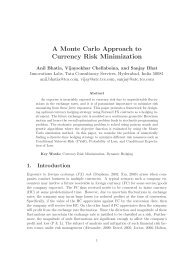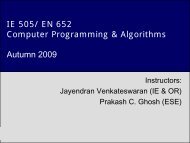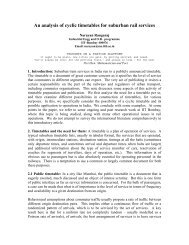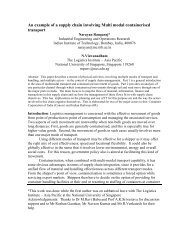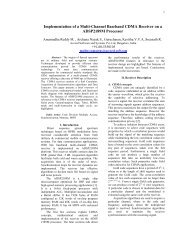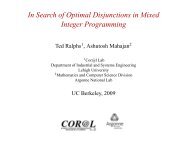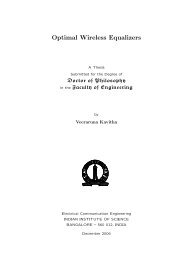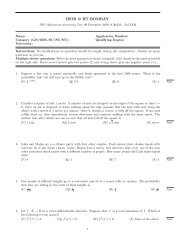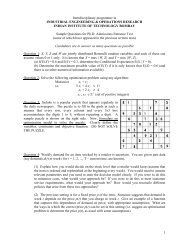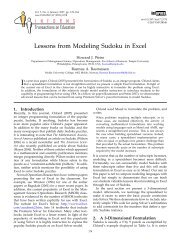Opportunistic Scheduling in Cellular Systems in the Presence of ...
Opportunistic Scheduling in Cellular Systems in the Presence of ...
Opportunistic Scheduling in Cellular Systems in the Presence of ...
Create successful ePaper yourself
Turn your PDF publications into a flip-book with our unique Google optimized e-Paper software.
1758 IEEE TRANSACTIONS ON INFORMATION THEORY, VOL. 58, NO. 3, MARCH 2012<br />
A. Contribution <strong>of</strong> <strong>the</strong> Paper<br />
We beg<strong>in</strong> with <strong>the</strong> case <strong>in</strong> which BS does not use any extra<br />
<strong>in</strong>telligence to deal with noncooperative mobiles (BS makes<br />
schedul<strong>in</strong>g decisions based only <strong>the</strong> signals from <strong>the</strong> mobiles).<br />
The only Perfect Bayesian Equilibrium (PBE) <strong>of</strong> <strong>the</strong> result<strong>in</strong>g<br />
signal<strong>in</strong>g game are <strong>of</strong> <strong>the</strong> babbl<strong>in</strong>g type: <strong>the</strong> noncooperative<br />
mobiles send signals <strong>in</strong>dependent <strong>of</strong> <strong>the</strong>ir channel states, and <strong>the</strong><br />
BS simply ignores <strong>the</strong>m to allocate channels based only on prior<br />
channel statistics (Section III). Fortunately, <strong>the</strong> BS can use more<br />
<strong>in</strong>telligent strategies to achieve a truth reveal<strong>in</strong>g equilibrium<br />
henceforth called as TRE. We present three ways to obta<strong>in</strong> <strong>the</strong>se<br />
as equilibria <strong>of</strong> an appropriate form <strong>of</strong> <strong>the</strong> game (Section IV).<br />
The first relies on capabilities <strong>of</strong> <strong>the</strong> BS to estimate <strong>the</strong> real downl<strong>in</strong>k<br />
channel quality (perhaps obta<strong>in</strong>ed at a later stage based on<br />
<strong>the</strong> rate at which <strong>the</strong> actual transmission took place), comb<strong>in</strong>ed<br />
with a pric<strong>in</strong>g mechanism that creates <strong>in</strong>centives for truthful signal<strong>in</strong>g.<br />
In <strong>the</strong> second approach, <strong>the</strong> BS learns mobiles’ signal<strong>in</strong>g<br />
statistics, correlates <strong>the</strong>m with <strong>the</strong> true channel statistics, and<br />
punishes <strong>the</strong> deceivers. We next come up with a practical strategy<br />
to achieve a TRE <strong>in</strong> <strong>the</strong> form <strong>of</strong> a variant <strong>of</strong> <strong>the</strong> proportional<br />
fair shar<strong>in</strong>g algorithm (PFA) which elicits truthful signals from<br />
mobiles (Section V). Fur<strong>the</strong>r, <strong>in</strong> Section VI, we establish <strong>the</strong><br />
existence <strong>of</strong> o<strong>the</strong>r equilibria at which <strong>the</strong> BS improves its utility<br />
<strong>in</strong> comparison to that obta<strong>in</strong>ed at a babbl<strong>in</strong>g equilibrium; <strong>the</strong><br />
noncooperative mobiles also improve <strong>the</strong>ir utilities over <strong>the</strong>ir<br />
cooperative shares (<strong>the</strong>ir utilities at a TRE).<br />
The set <strong>of</strong> strategies available to <strong>the</strong> mobiles and to <strong>the</strong> BS <strong>in</strong><br />
an extended game formalism is <strong>in</strong>deed huge. Given that <strong>in</strong>teractions<br />
are spread over time, <strong>in</strong> general, mobiles could choose<br />
to switch between cooperative and noncooperative behaviors. In<br />
this case, if <strong>the</strong> BS is unaware <strong>of</strong> a mobile’s reputation, it could<br />
try to <strong>in</strong>fer it by observ<strong>in</strong>g <strong>the</strong> reports and by compar<strong>in</strong>g <strong>the</strong>m<br />
with known statistics. It could <strong>the</strong>n adapt its schedul<strong>in</strong>g strategy<br />
appropriately. For simplicity, we do not consider <strong>the</strong>se possibilities<br />
<strong>in</strong> this paper.<br />
Some remarks on <strong>the</strong> assumption that <strong>the</strong> BS is aware <strong>of</strong> <strong>the</strong><br />
channel statistics, though not <strong>the</strong> <strong>in</strong>stantaneous channel ga<strong>in</strong>, are<br />
<strong>in</strong> order. In frequency division duplex (FDD) systems, average<br />
channel state may be available if <strong>the</strong> BS is aware <strong>of</strong> <strong>the</strong> mobile’s<br />
location. This may be available via BS-assisted position<strong>in</strong>g algorithms<br />
where <strong>the</strong> BS is <strong>in</strong>volved <strong>in</strong> <strong>the</strong> mobile’s localization.<br />
Cell-specific radio propagation simulators may <strong>the</strong>n be able to<br />
provide <strong>the</strong> average channel condition as well as channel statistics<br />
(see, e.g., [5] for some sophisticated channel models). In<br />
time division duplex (TDD) systems, <strong>the</strong> BS may make upl<strong>in</strong>k<br />
measurements and apply it to downl<strong>in</strong>k, thanks to upl<strong>in</strong>k-downl<strong>in</strong>k<br />
duality. Keep<strong>in</strong>g <strong>the</strong>se possibilities <strong>in</strong> m<strong>in</strong>d, we assume, for<br />
simplicity, that <strong>the</strong> BS has full knowledge <strong>of</strong> channel statistics.<br />
B. Prior Work<br />
PFA and related algorithms were <strong>in</strong>tensely analyzed as applied<br />
to CDMA/HDR and 3GPP HSDPA systems ([6]–[8], [10],<br />
[11], [20], [26]). Kushner and Whit<strong>in</strong>g [18] showed us<strong>in</strong>g stochastic<br />
approximation techniques that <strong>the</strong> asymptotic averaged<br />
throughput can be driven to optimize a certa<strong>in</strong> system utility<br />
function (sum <strong>of</strong> logarithms <strong>of</strong> <strong>of</strong>fset-rates). All <strong>the</strong> above works<br />
assume that <strong>the</strong> centralized scheduler has true <strong>in</strong>formation <strong>of</strong><br />
channel states.<br />
However, as seen <strong>in</strong> <strong>the</strong> simulations <strong>of</strong> Kong et al. [16], noncooperative<br />
mobiles can ga<strong>in</strong> <strong>in</strong> throughput (by 5%) but cause<br />
a decrease <strong>in</strong> <strong>the</strong> overall system throughput (by 20%). Nuggehalli<br />
et al. [22] considered noncooperation by low-priority latency-tolerant<br />
mobiles <strong>in</strong> an 802.11e LAN sett<strong>in</strong>g capable <strong>of</strong><br />
provid<strong>in</strong>g differentiated quality <strong>of</strong> service. Price and Javidi [25]<br />
consider an upl<strong>in</strong>k version <strong>of</strong> <strong>the</strong> problem with mobiles be<strong>in</strong>g<br />
<strong>the</strong> <strong>in</strong>formed parties on valuations <strong>of</strong> upl<strong>in</strong>ks (queue state <strong>in</strong>formation<br />
is available only at <strong>the</strong> respective mobiles).<br />
Our problem is closely related to signal<strong>in</strong>g games with cheap<br />
talk, i.e., signals <strong>in</strong>cur no costs [17, Sec. 7], for which it is well<br />
known that babbl<strong>in</strong>g equilibria exist. While <strong>the</strong> above works<br />
[22] and [25] use mechanism design techniques [13] to <strong>in</strong>duce<br />
truth revelation, with pric<strong>in</strong>g implemented via “carrots” on <strong>the</strong><br />
opposite l<strong>in</strong>k, our problem differs from mechanism design not<br />
only <strong>in</strong> not hav<strong>in</strong>g pric<strong>in</strong>g but also <strong>in</strong> consider<strong>in</strong>g <strong>the</strong> BS as a<br />
player.<br />
We now beg<strong>in</strong> with a precise formulation <strong>of</strong> <strong>the</strong> problem before<br />
proceed<strong>in</strong>g to solutions.<br />
II. PROBLEM FORMULATION<br />
Consider <strong>the</strong> downl<strong>in</strong>k <strong>of</strong> a wireless network with one BS.<br />
mobiles compete for <strong>the</strong> downl<strong>in</strong>k data channel. Time is divided<br />
<strong>in</strong>to small <strong>in</strong>tervals or slots. In each slot one <strong>of</strong> <strong>the</strong> mobiles<br />
is allocated <strong>the</strong> channel. Mobile can be <strong>in</strong> one <strong>of</strong> <strong>the</strong> channel<br />
states , where . Fad<strong>in</strong>g characteristics are<br />
<strong>in</strong>dependent across mobiles. Let<br />
be <strong>the</strong><br />
vector <strong>of</strong> channel ga<strong>in</strong>s <strong>in</strong> a particular slot. Its distribution is<br />
, where is <strong>the</strong> distribution <strong>of</strong> <strong>the</strong><br />
random variable . We assume mobile can estimate perfectly<br />
us<strong>in</strong>g pilots transmitted by <strong>the</strong> BS. Mobile sends signal<br />
to <strong>the</strong> BS to <strong>in</strong>dicate its channel ga<strong>in</strong>. Some mobiles (say<br />
those with <strong>in</strong>dices where ) are noncooperative<br />
and may signal a different (say good) channel condition<br />
o<strong>the</strong>r than <strong>the</strong>ir true channel (say bad) <strong>in</strong> order to be allocated<br />
<strong>the</strong> channel. Channel statistics and noncooperative mobile identities<br />
are common knowledge to all players. Signal values are<br />
chosen from <strong>the</strong> channel space itself, i.e., . BS makes<br />
a schedul<strong>in</strong>g decision based on signals .<br />
1) Utilities: Let denote <strong>the</strong> mobile to which channel is allocated.<br />
If , mobile gets a utility given<br />
by which depends only on its own channel state and <strong>the</strong><br />
allocation, but not on <strong>the</strong> signal. Thus<br />
1. An example function is<br />
where is <strong>the</strong> average received signalto-noise<br />
ratio (SNR). BS utility is <strong>the</strong> sum <strong>of</strong> mobile utilities<br />
Optimiz<strong>in</strong>g <strong>the</strong> BS’s sum utility results <strong>in</strong> an efficient solution,<br />
our ma<strong>in</strong> object <strong>of</strong> study. Fairness may be <strong>in</strong>corporated appropriately;<br />
see our extensions [14] where utilities are concave<br />
functions <strong>of</strong> long-term average throughputs.<br />
1 This is <strong>the</strong> case if <strong>the</strong> BS allocates based on <strong>the</strong> mobile’s signal when <strong>the</strong> signaled<br />
channel ga<strong>in</strong> is more than or equal to <strong>the</strong> true channel ga<strong>in</strong>. In <strong>the</strong> later<br />
sections that develop robust BS policies, we will come across situations when <strong>the</strong><br />
BS allocates to provide a utility (say ~u) different from <strong>the</strong> one requested. In <strong>the</strong>se<br />
cases, U (s ;h ;A)=1 m<strong>in</strong>f~u; f (h )g.



